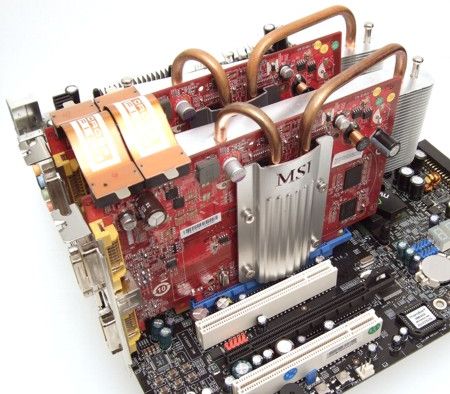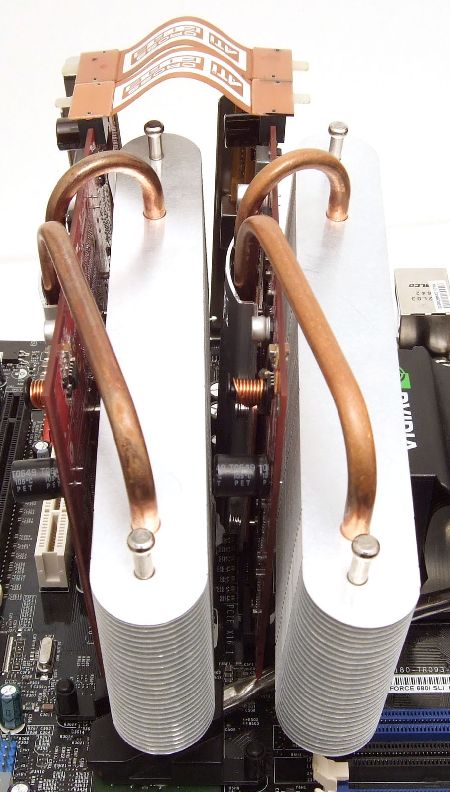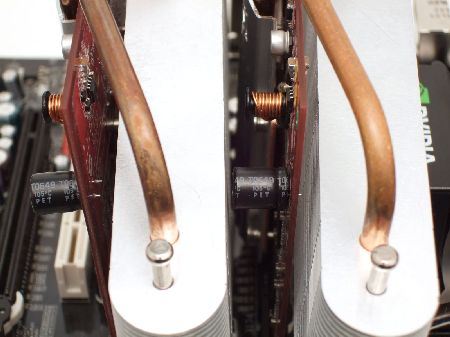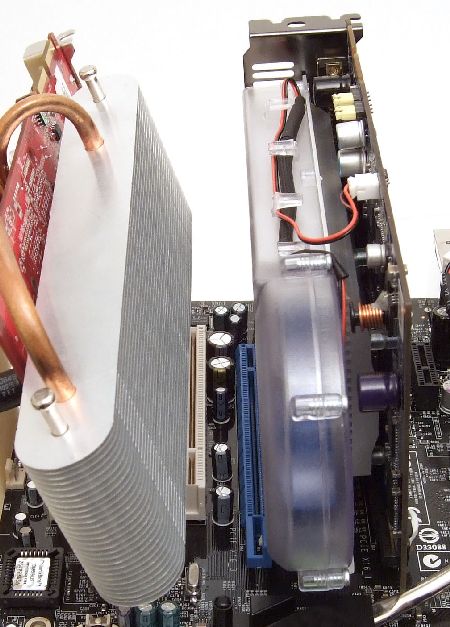6 Graphics Cards with Luxury Trimmings
MSI Radeon HD 2600 Pro Noise Free Edition Crossfire
MSI's Radeon 2600 Pro Noise Free Edition uses a silent passive heatpipe cooler
Sadly, MSI's Radeon HD 2600 Pro suffers from the same problem as its big sister, the 2600 XT: a large capacitor on the PCB interferes with the Crossfire installation. This is too bad, since MSI's passively cooled version is the perfect candidate for dual-card operation. After all, the single card only warms up to between 40°C and 53°C.
Luckily, despite the cramped quarters with two cards installed, benchmarking was not a problem, since we used an open (i.e. caseless) setup and did not fix the boards on place. With PCIe graphics (PEG) slots spaced the way they are on most motherboards, you can forget about using this exact combination of cards in a Crossfire setup inside a case. However, combining this card with other boards works just fine, as long as the Noise Free Edition is inserted in the first PEG slot. Otherwise, the cooler on the back may cause interference if your other card uses a large cooler. You can find below a few pictures detailing the installation and possible combinations, as well as pointing out potential difficulties.
The Crossfire setup is detected without a problem, and the two Radeon HD 2600 Pros operate completely stably as a duo. In Battlefield 2142, the dual-card setup offers performance gains between 43% and 71%. Here, the performance boost is actually less pronounced at higher resolutions. Doom 3 sees a performance boost between 14% and 82%, and again, the cards run out of steam at 1600x1200. Oblivion makes very good use of the additional rendering power: the frame rate almost doubles in this game, with performance increasing by at least 86%. Prey gets between 66% and 89% more performance out of the graphics duo, and this time, the performance boost remains evident even into high resolutions.
Overall, the dual-card configuration, with its cumulative frame rate of 1033.2 fps, trumps the 731.2 fps of the single-card setup by 41.3%. Two of MSI's Noise Free cards cost about $240. The slightly slower HIS Radeon HD 2600 XT Turbo for $112 (cumulative frame rate 977.8 fps) and Colorful's Geforce 8600 GT for $132 (cumulative frame rate 975 fps) make good alternatives.
A large capacitor on the first card comes into contact with the heatsink on the back of the second card.
While you can insert both cards, you won't be able to fix the second one in place.
Get Tom's Hardware's best news and in-depth reviews, straight to your inbox.
As long as the passively cooled MSI card sits in the first PCIe slot, there are no problems
With the MSI card in the second PCIe slot, the card's large heatsink gets in the way.
Current page: MSI Radeon HD 2600 Pro Noise Free Edition Crossfire
Prev Page MSI Radeon HD 2900 XT Crossfire Next Page HIS Radeon HD 2600 XT Zalman



